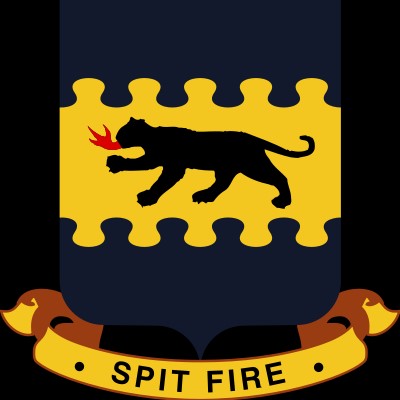Curtiss P-40F/L Warhawk
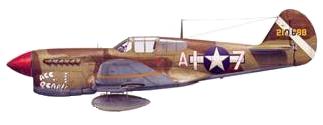
The ACE OF PEARLS flown by 2nd Lt.. Herman Ace Lawson, 99th FS, Madna, Italy, December 1943
Development of the P-40
Development of the P-40 began in 1938 as a
modification to the less well known P-36 Hawk. The application of
the Allison V-1710-19 aircraft engine producing 1,050 HP at 10,000
ft showed that the new aircraft would be fast at relatively low
altitudes. The proto-type of this fighter first flew on 14 October
1938. The following January the Curtiss submission had won the USAAC
competition for a new all metal single engine, single seat fighter
to supply the Air Corp. By December of 1939 the fighter had been
modified to meet required specifications and was ready for mass
production. This Curti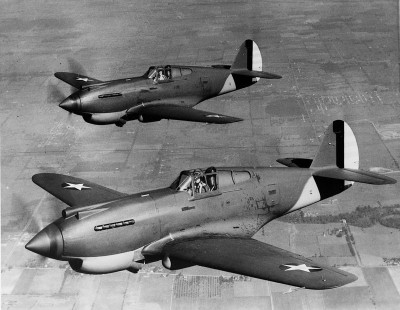 ss
fighter was the first American fighter type to see full mass
production on a large scale. It entered into the USAAC as the most
modern fighter available to the U.S. upon its entry into World War
II.
ss
fighter was the first American fighter type to see full mass
production on a large scale. It entered into the USAAC as the most
modern fighter available to the U.S. upon its entry into World War
II.
The P-40 saw a relatively long production
life with many variants and upgrades to the initial power-plant and
airframe. In a very short period of time the Curtiss P-40 became
outclassed by other fighters from nations abroad, mainly the
Supermarine Spitfire, Messerschmitt BF-109 and the Mitsubishi A6M
Zero. These fighters well out perfo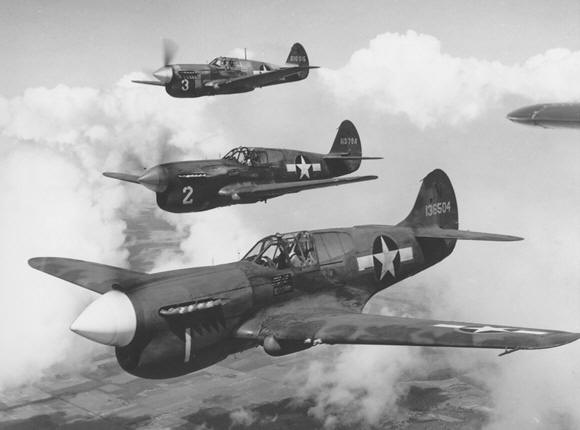 rmed
the P-40 in its current version the B/C variants. The USAAC moved
forward with training in the P-40, drilling Air Corp pilots
frequently. By 7 December 1941, the date America entered into World
War II, the P-40 was widely deployed to Army Air Corp units.
rmed
the P-40 in its current version the B/C variants. The USAAC moved
forward with training in the P-40, drilling Air Corp pilots
frequently. By 7 December 1941, the date America entered into World
War II, the P-40 was widely deployed to Army Air Corp units.
The only two pilots that made it aloft during the Imperial Japanese Naval attack on Pearl Harbor Hawaii were flying the P-40. These two pilot were responsible for knocking down five enemy aircraft on this day. The P-40 was a successful allied lend-lease program aircraft. The British, French and Soviets all ordered large quantities of the aircraft. Unfortunately, for the French their orders for the aircraft were too late as the Nazi Wehrmacht and Luftwaffe overan the French, as France capitulated in the summer of 1940.
At this time it was apparent that the P-40 would need to be upgraded to keep pace with other fighter types in the skies over battlefields of the time. The P-40C model receive many improvements that essentially created a new airplane. Marked by a deeper chin radiator, the P-40 Tomahawks gave way to the new Warhawks. The new P-40s profile visibly differed from earlier versions. Curtiss also switched the four wing-mounted 30 cal. guns to six heavy Browning 50 calibers, and got rid of the nose-mounted guns. With the loss of the nose mounted guns so went the need for the through-the-prop synchronization gear. With a more powerful Allison 1710-39, the P-40 Warhawk could now make 362 MPH in level flight.
The 99th Fighter Squadron goes to war!
USAAF Fighter Groups were deploying to
battle areas of the frontlines in the Pacific North, West, South and
Central-Pacific, Middle-East, and North Africa. In 1943 the 99th
Fighter Squadron received orders to deploy to North Africa. The
squadron had been well versed in the usage of the P-40B/C models
from the advanced training taken at Tuskegee Army Air Field. When
the unit arrived in Mor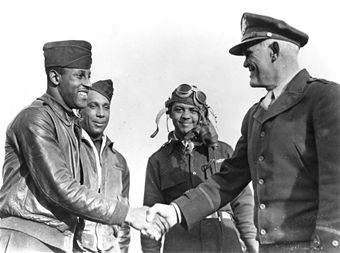 occo,
North Africa in April of 1943 it was equipped with the type of
aircraft common to the theater, mainly the P-40F and its more
heavily used variant the L model. The 99th FS flew the L
version and very small numbers of the F versions of the P-40. This
model of the P-40 had incorporated the license built Packard
Rolls-Royce Merlin that was used in the Spitfire and Hurricanes of
the RAF. These aircraft engines boosted high altitude performance of
the P-40 with a turbo supercharger. The L version carried less fuel
and two less 50 cal. machine guns in the wings to reduce weight and
increase overall performance.
occo,
North Africa in April of 1943 it was equipped with the type of
aircraft common to the theater, mainly the P-40F and its more
heavily used variant the L model. The 99th FS flew the L
version and very small numbers of the F versions of the P-40. This
model of the P-40 had incorporated the license built Packard
Rolls-Royce Merlin that was used in the Spitfire and Hurricanes of
the RAF. These aircraft engines boosted high altitude performance of
the P-40 with a turbo supercharger. The L version carried less fuel
and two less 50 cal. machine guns in the wings to reduce weight and
increase overall performance.
The 99th FS was attached to the
33rd Fighter Group commanded by Colonel William Momyer.
Racist views in a segregated Army Air Corp led to the unusually slow
transition to combat for the 99th FS. Training in combat
tactics were very sporadic coming from the 33rd Fighter
Group. The 99th FS had been deployed for more than two
months when on
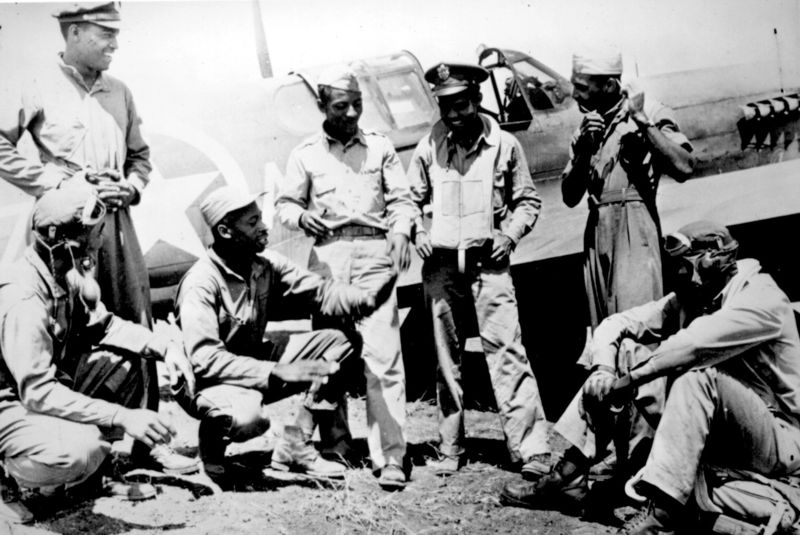 2
July 1943, 1st Lt. Charles B. Hall became the first
African American combat pilot to shoot down an enemy aircraft in a
Curtiss P-40L. After the North African campaign the 99th
FS was transferred to the 79th FG lead by Colonel Earl
Bates.
2
July 1943, 1st Lt. Charles B. Hall became the first
African American combat pilot to shoot down an enemy aircraft in a
Curtiss P-40L. After the North African campaign the 99th
FS was transferred to the 79th FG lead by Colonel Earl
Bates.
As the squadron battled its way across Italy gaining valuable air to ground combat experience, their air to air victories staled for several months. They were not to see another air to air victory until January of 1944. The 99ths value as a combat unit was very seriously questioned by political and War department groups back in Washington D.C. The Squadron had finally transitioned to the 79th FG who's job it was to fly cover over the beachhead of Anzio during the Anglo-American invasion that was scheduled to begin on 22 January 1944. The Luftwaffe had been ordered to stop the invasion on the beaches as many FW-190 dive bombers attacked the beachhead at Anzio. During the weeks to come a miraculous story began to unfold.
During the winter and spring of 1944 over the Beachhead at Anzio large air battles for control of the airspace in the area took place. Between 5 February and 2 April 1944 over the Beachhead at Anzio the 99th shot down 17 enemy aircraft. They outscored the three other regular squadrons of the 79th FG. This was a milestone in the maturity and combat prowess of the 99th FS, making the squadron tops on the list for a new assignment of bomber escorts as it was now assigned to Ramatelli Army Airfield in Foggia, Italy as part of the All Black 332nd Fighter Group.
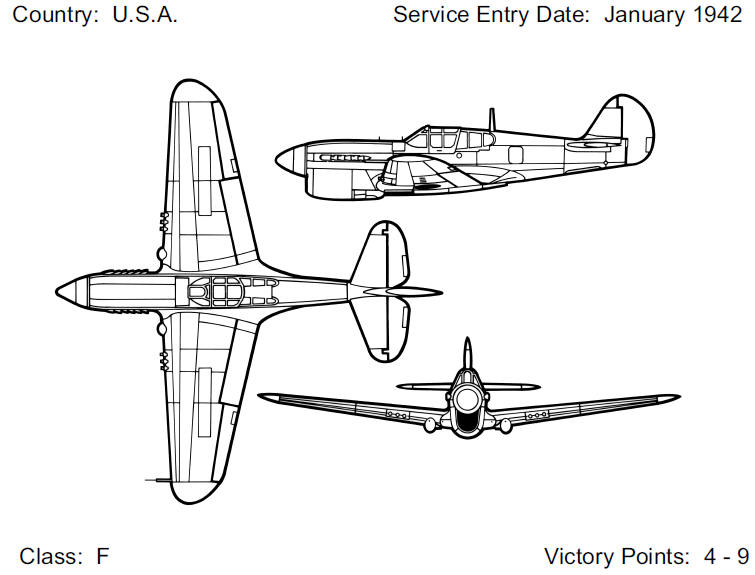
Curtiss P-40F/L Warhawk Specifications
| Power Plant: | Packard Merlin V-1650-1 12 cylinder liquid cooled |
| Horsepower: | 1300 HP for takeoff, 1120 HP @18,500 ft. |
| Maximum Spped: | 364 MPH @ 20,000 ft. |
| Rate of Climb: | 2,220 ft. per minute to 10,000 ft. |
| Maximum Range | 700 miles @ 20,000 ft. (clean), 875 miles w/43 gal. drop tank, 1500 miles w/141.5 gal. drop tank. |
| Service Ceiling: | 34,300 ft. |
| A/C Weight: | 6590 Empty weight, 8500 Normal weight, 9350 Gross Takeoff weight |
| Wing Span: | 37 ft. 4 inches |
| Fuselage Length: | 33 ft. 4 inches |
| Height: | 10 ft. 7 inches |
| Wing Area: | 236 sq. ft. |
| Armament: | /F(6) 50 cal. /L(4) 50 cal. |
 |
|

